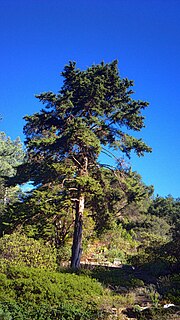
Santa Cruz de la Sierra, commonly known as Santa Cruz, is the largest city in Bolivia and the capital of the Santa Cruz department.

Santa Cruz, with an area of 370,621 km2 (143,098 sq mi), slightly smaller than Japan or the US State of Montana, it is the largest of the nine constituent departments of Bolivia occupying about one-third (33.74%) of the territory of the country. It is located in the eastern part of the country, sharing borders in the north and east with Brazil and with Paraguay in the south.

The red-fronted macaw is a parrot endemic to a small semi-desert mountainous area of Bolivia. It is a critically endangered species; it has been successfully bred in captivity, and is available, if not common, as a pet. It is also sometimes known in the literature as Lafresnaye's macaw, named for the French ornithologist Frédéric de Lafresnaye, who was one of the first to describe the species.
Parodiodendron is a monotypic plant genus under the family Picrodendraceae, described as a genus in 1969. The sole species is Parodiodendron marginivillosum. It is found in northern Argentina, Bolivia and Peru.

The Santa Cruz cypress is a species of North American tree within the Cypress family. The species is endemic to the Santa Cruz Mountains within the Santa Cruz and San Mateo counties of west-central California. The U.S. Fish and Wildlife Service listed the species on the Endangered Species Act in 1987 due to increasing threats from habitat loss and disruption of natural forest fire regimes. In 2016, the conservation status of the Santa Cruz cypress changed to Threatened. The cited reasoning was a decrease in threats against their habitat.

Noel Kempff Mercado National Park is a national park in northeast Santa Cruz Department, Province of José Miguel de Velasco, Bolivia, on the border with Brazil.

Tomes's sword-nosed bat, also known as the common sword-nosed bat is a bat species from South and Central America. It is also found in the Bahamas, as is known only from one specimen collected on the island of New Providence.

Trithrinax brasiliensis is a species of flowering plant in the family Arecaceae. It is known as carandá, burití or leque. It is considered a rare and endemic species in southern Brazil. It occurs in Argentina, southern Brazil, and eastern Bolivia, where it is popularly known to Spanish speakers as saó or saocito and to speakers of Chiquitano as baixhíxh. Nowadays it is considered a threatened species belonging to the category "In Danger" in the List of Threatened species of Rio Grande do Sul state, southern Brazil.
Rhinella amboroensis is a species of toad in the family Bufonidae that is endemic to the region of its type locality in the Carrasco Province of Bolivia and the adjacent Santa Cruz Department. Its common name is Cochabamba toad. It may exist in the Carrasco National Park and/or Amboró National Park, depending on its exact range.
Rhinella stanlaii is a species of toad in the family Bufonidae. It is endemic to Bolivia and occurs on the Amazonian versant of the Bolivian Andes in the Cochabamba, La Paz, and Santa Cruz departments.
Pristimantis samaipatae is a species of frog in the family Craugastoridae. It is found in the Santa Cruz and Tarija Departments of eastern Bolivia and in adjacent Argentina. Its natural habitats are semi-humid montane forests. It is a common frog that is not threatened.
Gastrotheca piperata is a species of frog in the family Hemiphractidae.
Psychrophrynella kempffi is a species of frog in the family Craugastoridae. It is endemic to Bolivia where it is known from the Serranía Siberia in the Cochabamba and Santa Cruz Departments. Its natural habitats are cloud and elfin forests where it has been found near rocks along a road, under stones and logs, on moss, and on tree roots. It can be active both day and night. It is threatened by habitat loss, and potentially, by climate change.
Ficus aguaraguensis is a species of plant in the family Moraceae. It is endemic to Bolivia. It is threatened by habitat loss.
Ficus castellviana is a species of plant in the family Moraceae. It is found in Bolivia, Brazil, Colombia, and Peru.
Ficus krukovii is a species of plant in the family Moraceae. It is found in Bolivia, Brazil, and Venezuela.
Ficus pallida is a species of plant in the family Moraceae. It is found in Brazil, Colombia, and eastern Bolivia. In Bolivia, it is one of a few closely related trees in the genus Ficus popularly known as bibosi.
Ficus schippii is a species of plant in the family Moraceae. It is found in Bolivia, Brazil, and Peru.
Ficus sphenophylla is a species of Fig tree in the family Moraceae. It is found in Bolivia, Brazil, Colombia, and Peru.
Flabellidium is an extinct genus of moss in the family Brachytheciaceae. It contains a single species, Flabellidium spinosum, also known as the Santa Cruz bryophyte.







